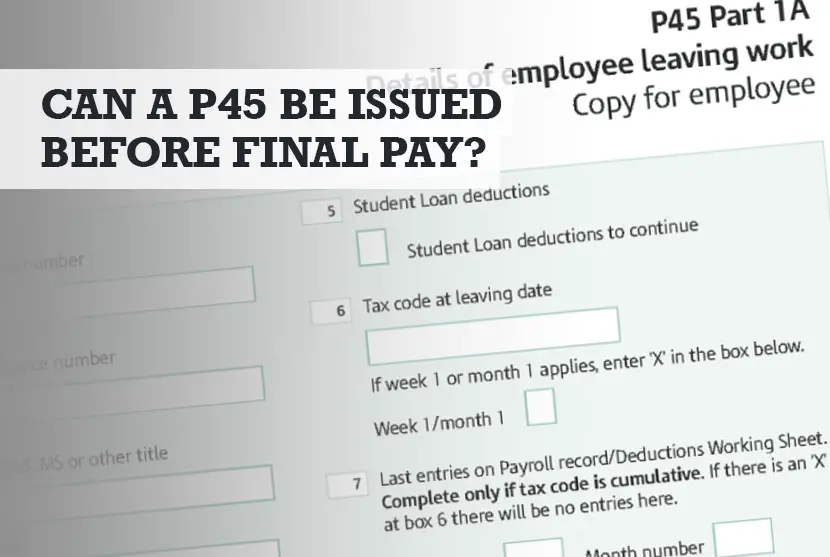When leaving a job, employees often receive a P45 form, which is an important document for tax purposes in the United Kingdom. However, questions may arise about the timing of issuing a P45 and its implications for final pay and subsequent employment.
In this short guide we will explore the various aspects related to the issuance and use of P45 forms, and whether they can be issued before final pay.
Yes, a P45 can be issued before the final pay is made to the employee. In some cases, an employee may leave a job close to the end of a pay period, and the final pay might not be processed immediately. In such situations, the employer can still issue the P45 to the employee with the accurate information about their earnings and deductions up to the date of leaving.
P45 issue date queries
The P45 is a form that employers provide to employees when they leave a job. It contains important information about the employee’s earnings and the tax that has been deducted up until the date of leaving the job.
How soon should a P45 be issued?
The P45 should be issued to the employee as soon as possible after they leave the job, and can be before final pay if needed. The timing of the final pay might vary depending on the company’s payroll schedule or any relevant employment laws or regulations.
It’s essential for the employer to ensure that the information on the P45 is accurate and reflects the correct earnings and deductions up to the date of leaving. If there are any changes or corrections needed, the employer should update the P45 accordingly and provide the amended version to the employee.
It’s worth noting that the P45 is not a payment document but rather a tax document. The actual payment of the final wages owed to the employee should be made separately from providing the P45.
How soon should a P45 be issued?
According to HM Revenue and Customs (HMRC) guidelines, employers should issue a P45 to an employee without delay once they cease employment. Ideally, the P45 should be provided on or before the employee’s last working day.
Can you use a P45 after the first payment?
Yes, a P45 can be used after receiving the first payment from a new employer. When starting a new job, it is common for employees to provide their P45 to their new employer, who will use the information on the form to ensure correct tax deductions going forward.
If you leave employment in one tax year and do not start new employment until after the beginning of the new tax year the previous P45 is redundant. You will have a new personal tax allowance for the new tax year and your year-to-date gross pay and tax calculations will reset. The tax code on the previous P45 becoming invalid.
For clarity in the UK the tax year runs from 6th April to 5th April each year.
Can a P45 be reissued?
In most cases, a P45 cannot be reissued. However, if there are errors on the original P45 or if the employee misplaces it, the employer can provide a letter confirming the relevant details for tax purposes. It is essential to keep a copy of the original P45 for personal records.
More FAQs on issuing P45s
Can you get paid after receiving a P45?
Yes, you can get paid after receiving a P45. A P45 is a form issued by employers to employees when they leave a job. It summarises the employee’s pay and tax details during their employment. Receiving a P45 indicates that you have ceased working for that employer.
If you leave a job and receive a P45, it does not mean that you won’t receive your final pay or any outstanding wages or entitlements owed to you. Your employer should still settle any payments due to you, including salary for the period worked, unused accrued holiday days, bonuses, or other entitlements as per your employment contract or legal requirements.
The P45 is mainly for tax purposes, and it provides important information to HM Revenue and Customs (HMRC) about your income and tax deductions up until the date of leaving the job. When you start a new job after leaving the previous one, you should give your new employer the P45, as it helps them calculate your income tax correctly.
If there are any issues with receiving your final pay or any other concerns related to your employment, you may need to communicate with your previous employer or seek advice from an employment rights organisation or legal professional. It’s essential to ensure that you receive all the payments and entitlements you are owed according to your contract and relevant employment laws.
So, yes, it is possible to receive payment after receiving a P45. The P45 is primarily a document for tax purposes, and its issuance does not directly impact the payment schedule or entitlement to final pay. Employers are responsible for ensuring timely and accurate payment, irrespective of the P45 issuance.
Did You Know? Here’s what you should do if your employer won’t give you a P45.
How long does an employer have to issue a P45 in the UK?
As mentioned earlier, employers should issue a P45 without delay, ideally on or before the employee’s last working day. However, there is no specific legal timeframe provided by HMRC regarding the exact number of days an employer must issue a P45.
Received a P45 but still employed: What does it mean?
If an employee receives a P45 but is still employed by the same company, it may indicate an administrative error. It is important to inform the employer about the situation, as it could affect the accuracy of tax deductions and future employment records.
When should I get my P45 when I leave my job?
Employees should typically receive their P45 on or before their last working day. This document provides important information for tax purposes and ensures that future tax deductions are calculated correctly.
The P45 cannot be issued until the last payment has been processed for the employee. If you left employment on the 14th July 2023 but the payday for the employer was the last working day say 31st July 2023 you would not be able to get a P45 from the old employer until after the payroll had been processed on the 31st July 2023.
This ensures that the year-to-date figures provided to your new employer for gross pay and tax year to date are correct and your new pay starts from the correct position.
If you do not have a P45 before your first payment date with your new employer you should complete the HMRC Starter Checklist.
The Starter Checklist serves the same purpose as the P46, helping employers gather the relevant information needed to set up an employee’s tax code.
The Starter Checklist includes questions about the employee’s employment status, any other sources of income, and whether they are entitled to claim the UK Personal Allowance (tax-free amount). Based on the answers provided in the Starter Checklist, the employer can determine the appropriate tax code to apply for the employee.
The use of the P46 form has been discontinued, so if you are a new employee in the UK, your employer will likely provide you with a Starter Checklist instead to collect the necessary tax information.
P45 leaving date wrong: What should I do?
If the leaving date on your P45 is incorrect, you should contact your employer immediately to rectify the mistake. It is crucial to have accurate employment records for tax purposes, so any errors should be addressed promptly.
If the leaving date falls into the wrong tax month or tax year it could indicate that your year-to-date tax deductions are incorrect. This may mean you have underpaid or overpaid tax and this may or may not mean a year-to-date correction when you start your new employment, or it gets picked up by HMRC after the tax year. Either way you do not want any nasty surprises with your P45 leaving date being wrong so we would suggest contacting your old employer straight away and preferably corrected before your first pay from your new employer.
Can a P45 be amended?
Once a P45 has been issued, it cannot be amended. However, if there are errors on the P45, your employer can issue a new P45 or provide a letter with the corrected information. It is important to retain all versions for accurate tax reporting.
Employers can make amendments to a P45 for the tax year it was issued as long as the changes are accurate and reflect the correct information. The process for amending a P45 depends on the type of correction required:
- Employee Details: If there are errors in the employee’s personal details, such as name, address, or National Insurance number, the employer can correct this on the P45 and issue a new one with the accurate information.
- Tax and Payroll Information: If there are errors in the tax and payroll information, such as total pay or tax deductions, the employer should contact HM Revenue and Customs (HMRC) to inform them about the correction. They will provide guidance on how to update the information correctly.
- Overdue P45: If a P45 was not issued on time, or there was a delay in providing it to the employee, the employer can still issue a P45 with the correct details and date it to reflect when the employee actually left the job.
It is essential for employers to ensure that the amended P45 is accurate and reflects the correct information before providing it to the employee and submitting it to HMRC. Incorrect or false information on a P45 can lead to issues with tax calculations and compliance. If you are an employee and believe there is an error on your P45, you should discuss it with your employer and ask them to make the necessary corrections. If you have concerns or encounter difficulties, you can seek advice from HMRC or a tax professional for guidance on the correct procedures for amending a P45.
Calculating National Insurance (NI) on payment after leaving
When calculating National Insurance contributions on a payment made after leaving employment, it is crucial to ensure that the correct NI category and rates are applied. Employers should consult HMRC guidelines or seek professional advice to ensure accurate NI calculations.
National Insurance (NI) contributions are usually calculated and deducted from an individual’s earnings while they are employed. However, there are specific situations where NI contributions may still be applicable on payments made after leaving a job. Here are some scenarios:
- Payment of Arrears: If you receive arrears of pay for work done during your employment, National Insurance contributions may still apply. Arrears could include unpaid salary, bonuses, or commissions that were earned while you were employed but were not paid until after you left the job.
- Notice Pay: If you receive payment for your notice period after leaving your job, National Insurance contributions are still applicable as this payment is considered earnings.
- Redundancy Pay: Statutory redundancy pay is generally not subject to National Insurance contributions. However, any additional redundancy pay that exceeds the statutory limit may be subject to NI contributions.
- Payments in Lieu of Notice (PILON): If you receive a payment in lieu of notice instead of serving out your notice period, it is usually treated as earnings for tax and National Insurance purposes.
- Post-Employment Benefits: Some post-employment benefits or payments, such as certain pension benefits or termination payments, may also be subject to National Insurance contributions.
It is important to note that the specific tax and National Insurance treatment of payments made after leaving a job can vary depending on the circumstances and the amounts involved. Different rules may apply to different types of payments. Therefore, it is advisable to seek advice from HM Revenue and Customs (HMRC) or a qualified tax professional to ensure that you are aware of any National Insurance obligations related to your specific situation. HMRC can provide guidance on how to handle NI contributions and taxes for payments received after leaving your job.
What to do if your employer won’t give you a P45?
If your employer refuses or fails to provide you with a P45 when you leave your job, there are several steps you can take to address the situation:
- Communicate with Your Employer: First, try to communicate with your employer and request your P45 again in writing. Be polite and clear in your communication, specifying the date you left the job and the reason you need the P45. Keep a record of all correspondence.
- Contact HM Revenue and Customs (HMRC): If your employer continues to refuse to issue a P45, you should contact HMRC to inform them about the situation. You can do this by calling the HMRC helpline or using the online services available on the official HMRC website.
- Provide Details to Your New Employer: If you start a new job before receiving your P45, inform your new employer about the situation. They can use the information on your last payslip or other details to set up your tax code until you receive your P45.
- Check for Correct Tax Deductions: Ensure that your new employer is deducting the correct amount of tax from your pay by checking your payslips and tax code. You can verify your tax code with HMRC if needed.
- Keep Records: Keep records of all communication with your previous employer, as well as any details related to your new employment, including payslips and tax deductions.
- Seek Legal Advice: If your employer’s refusal to provide a P45 causes significant issues or if there are further complications, consider seeking legal advice from an employment rights organization or a solicitor with expertise in employment law.
It is important for employers to provide employees with a P45 as it contains crucial information for tax purposes. If your employer persists in not providing a P45 or if there are any concerns about your rights as an employee, taking appropriate action and seeking advice can help protect your interests.
Conclusion
The issuance and use of P45 forms play a crucial role in the tax administration process when leaving a job. Employers should aim to provide the P45 to employees promptly upon cessation of employment, but this can mean a P45 can be issued before final pay.
While a P45 is primarily used for tax purposes, it does not directly impact final pay or subsequent employment. Should any issues arise, employees should communicate with their employer to rectify errors or obtain the necessary documentation to ensure accurate tax reporting.

Jon has been in business since 1999, and in that time worked with more than 300 small business clients. As well as being an accountant, he is also an early adopter of tech, and has helped small businesses to leverage the power of their computer systems by creating software to automate and simplify accounting tasks.






